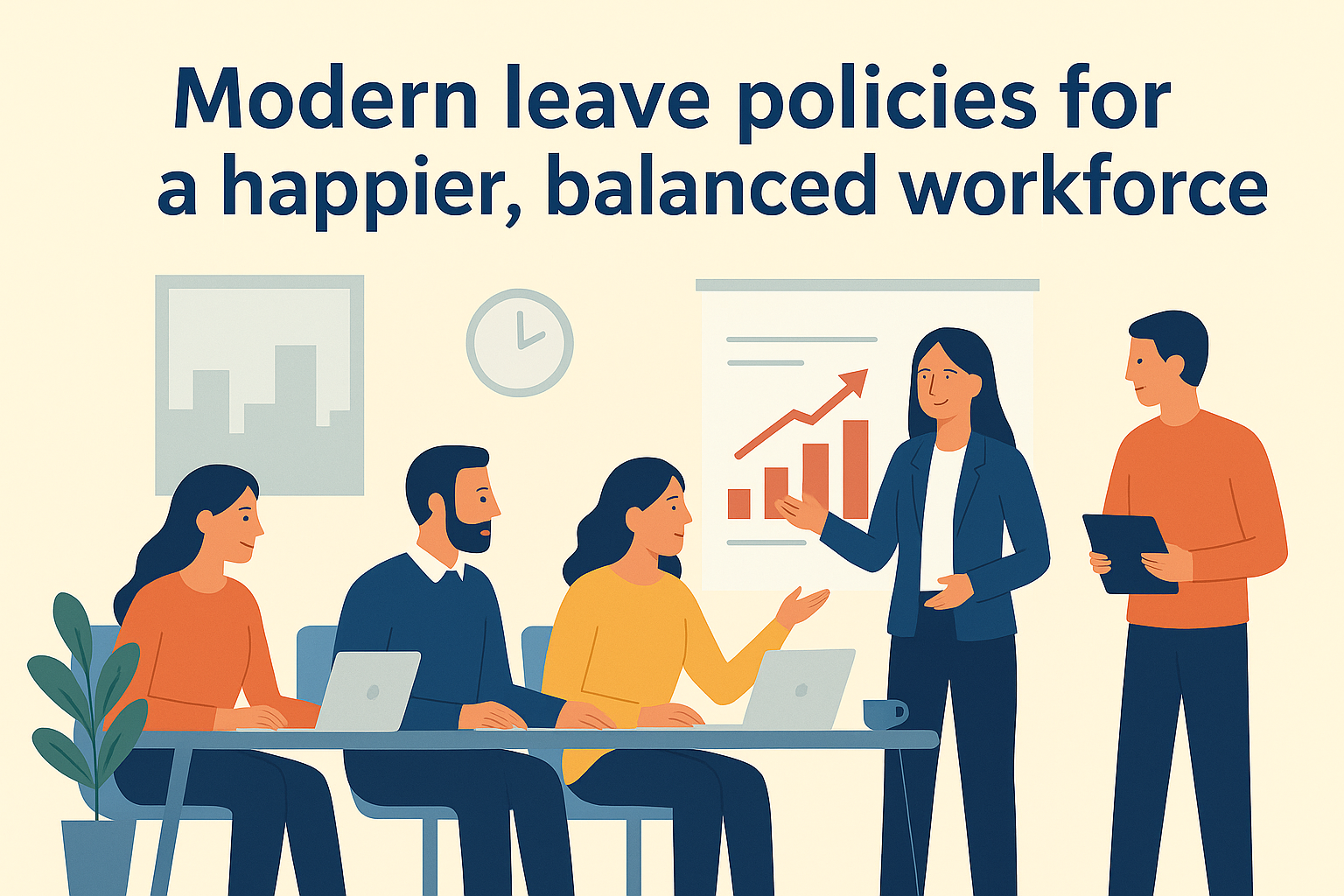Workplaces are changing faster than ever before. Remote work, hybrid models, and flexible hours have become normal. Teams today collaborate across cities, countries, and even time zones. However, one area that has not evolved at the same speed is employee leave policy.
Most companies still follow traditional leave systems designed years ago when work meant fixed office hours and standard family structures. But today’s workforce is more diverse. Employees expect not only job security and salary but also support, inclusion, and balance between work and personal life.
To meet these expectations, organizations must modernize their leave policies. A well-designed leave policy is no longer just a formality, it’s a key part of building a future-ready and employee-focused workplace.
1. Understanding General Leave Policies
Traditionally, organizations provide a few standard types of leaves to their employees. These usually include:
- Sick Leave – For recovery from illness or medical treatment (7–12 days per year).
- Casual Leave – For short-term personal reasons or emergencies (8–10 days per year).
- Earned or Privilege Leave – Accumulated over time, used for vacations or extended breaks.
- Maternity and Paternity Leave – For childbirth or adoption, governed by labor laws.
While these policies have worked for a long time, they often fail to address the needs of today’s employees.
Modern professionals face challenges like mental stress, caregiving duties, emotional fatigue, and changing family roles, situations not covered by older frameworks.
This gap has led many companies to rethink their leave policies and make them more flexible and inclusive.
2. Why Leave Policies Need an Update
Companies that want to retain talent and maintain productivity must look beyond old systems. Employee expectations have changed, and HR policies must evolve accordingly.
Why updating leave policies is important:
a. Changing Workforce
Millennials and Gen Z now form most of the workforce. They value flexibility, mental health, and meaningful work. An outdated policy doesn’t align with their needs or work style.
b. Mental Health Awareness
After the pandemic, awareness around mental well-being has increased sharply. Employees now expect companies to treat mental health as seriously as physical health.
c. Caregiving Responsibilities
Many employees today manage both work and caregiving — whether it’s for children, aging parents, or ill family members. Modern policies need to support this balance.
d. Inclusion and Diversity
Workplaces today are more diverse than ever. Policies should reflect this by addressing the unique needs of all employees, regardless of gender, background, or family situation.
e. Retention and Productivity
Companies that care for their employees’ well-being see higher retention and engagement. A flexible leave structure helps reduce burnout and keeps productivity steady.
3. Modern Leave Options for Today’s Workforce
Progressive organizations are expanding their leave structures to fit the needs of modern employees.
Types of new-age leaves that companies are adopting:
a. Mental Health Leave
Not every health issue is visible. Stress, anxiety, and emotional exhaustion affect work performance. Mental health leave allows employees to take time off to rest, seek therapy, or recharge, without stigma.
b. Menstrual Leave
Some organizations offer menstrual leave to women and transgender employees. It helps them manage discomfort and promotes inclusivity in the workplace.
c. Caregiver Leave
This leave supports employees who must care for sick parents, children, or spouses. It recognizes that family responsibilities are part of life, not distractions from work.
d. Bereavement Leave
Time off after the loss of a loved one helps employees recover emotionally. It also shows that the company values people beyond their work output.
e. Sabbatical Leave
A long-term break offered to employees after several years of service. It allows time for rest, upskilling, or personal projects, a great way to build long-term loyalty.
f. Volunteer or Community Service Leave
Many companies allow paid days off for community service or volunteering. This supports corporate social responsibility and gives employees a sense of purpose.
g. Marriage Leave
Time off for one’s wedding or close family functions. Small but meaningful, it helps employees manage personal milestones without stress.
h. Flexible or Work-from-Anywhere Leave
Some organizations let employees work remotely while attending to personal matters, reducing absenteeism while maintaining productivity.
i. Study or Exam Leave
Time off for employees pursuing higher education or certifications, showing the company’s support for continuous learning and career growth.
4. Companies Leading the Change
Several companies in India and globally are already modernizing their leave policies.
Here are some examples worth noting:
- Zomato: Offers up to 10 days of paid menstrual leave per year for women and transgender employees.
- Hindustan Unilever (HUL): Introduced a Kinship or Caregiver Leave Policy with up to 4 weeks of paid time off.
- Urban Company: Provides unlimited sick leave that covers both physical and mental health.
- Acer India: Offers one paid menstrual leave day per month under its “Matrika” program.
- Microsoft India: Allows up to 4 weeks of Family Caregiver Leave.
- SAP Labs and Accenture: Include dedicated mental health and wellness days in their annual calendars.
- Google and Meta (Global): Provide extended parental, bereavement, and caregiver leaves as part of their inclusive culture.
5. How Updated Leave Policies Improve Work Culture
Revising leave structures is not just an HR task, it’s a cultural decision. A good leave policy helps build a workplace where employees feel respected, understood, and valued.
How better leave policies strengthen work culture:
a. Higher Employee Morale
When employees feel supported during tough times, their trust in the organization grows. This leads to higher motivation and better engagement.
b. Reduced Burnout and Turnover
Employees who can take time off to rest or handle personal matters come back refreshed and more productive. This helps reduce stress and turnover.
c. Better Employer Branding
Companies known for caring policies attract top talent. A modern leave policy signals that the company is progressive, fair, and people-first.
d. Encourages Openness
Policies like mental health or menstrual leave help normalize discussions that were once avoided. This leads to a more open and inclusive environment.
e. Sustained Productivity
A well-rested employee performs better and thinks more clearly. Balanced leave policies ensure consistent performance without overwork or burnout.
Ultimately, leave policies that value people help create a culture built on trust and empathy, not fear and control.
6. The Role of Leave Policies in Work-Life Balance
Work-life balance is no longer a luxury, it’s a basic expectation.
Organizations that recognize this reality are the ones shaping the future of work.
When companies give employees time to rest, recover, and manage personal responsibilities, they see higher loyalty and commitment in return. Employees no longer view work as a burden but as a part of a well-rounded life.
Modern leave policies show that a company values its people as humans first, employees second. This empathy-driven approach builds long-term success, for both the individual and the organization.
Conclusion
The workplace is evolving, and so should company policies.
Updating leave structures is one of the simplest yet most powerful steps an organization can take toward building a future-ready culture.
When employees are supported through mental health breaks, caregiving time, or learning opportunities, they perform better and stay longer.
Modern leave policies are not just about offering more days off, they’re about building a workplace that values balance, inclusion, and well-being.
In the end, a company’s biggest strength is its people. When they feel supported, the organization naturally grows stronger, more resilient, and more future-ready.
I hope you find the above content helpful. For more such informative content, please visit HR Global Hub.











